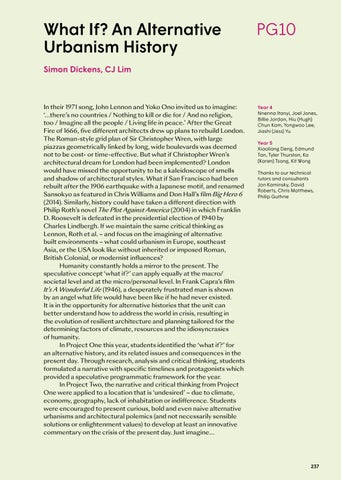What If? An Alternative Urbanism History
PG10
Simon Dickens, CJ Lim
In their 1971 song, John Lennon and Yoko Ono invited us to imagine: ‘…there’s no countries / Nothing to kill or die for / And no religion, too / Imagine all the people / Living life in peace.’ After the Great Fire of 1666, five different architects drew up plans to rebuild London. The Roman-style grid plan of Sir Christopher Wren, with large piazzas geometrically linked by long, wide boulevards was deemed not to be cost- or time-effective. But what if Christopher Wren’s architectural dream for London had been implemented? London would have missed the opportunity to be a kaleidoscope of smells and shadow of architectural styles. What if San Francisco had been rebuilt after the 1906 earthquake with a Japanese motif, and renamed Sansokyo as featured in Chris Williams and Don Hall’s film Big Hero 6 (2014). Similarly, history could have taken a different direction with Philip Roth’s novel The Plot Against America (2004) in which Franklin D. Roosevelt is defeated in the presidential election of 1940 by Charles Lindbergh. If we maintain the same critical thinking as Lennon, Roth et al. – and focus on the imagining of alternative built environments – what could urbanism in Europe, southeast Asia, or the USA look like without inherited or imposed Roman, British Colonial, or modernist influences? Humanity constantly holds a mirror to the present. The speculative concept ‘what if?’ can apply equally at the macro/ societal level and at the micro/personal level. In Frank Capra’s film It’s A Wonderful Life (1946), a desperately frustrated man is shown by an angel what life would have been like if he had never existed. It is in the opportunity for alternative histories that the unit can better understand how to address the world in crisis, resulting in the evolution of resilient architecture and planning tailored for the determining factors of climate, resources and the idiosyncrasies of humanity. In Project One this year, students identified the ‘what if?’ for an alternative history, and its related issues and consequences in the present day. Through research, analysis and critical thinking, students formulated a narrative with specific timelines and protagonists which provided a speculative programmatic framework for the year. In Project Two, the narrative and critical thinking from Project One were applied to a location that is ‘undesired’ – due to climate, economy, geography, lack of inhabitation or indifference. Students were encouraged to present curious, bold and even naive alternative urbanisms and architectural polemics (and not necessarily sensible solutions or enlightenment values) to develop at least an innovative commentary on the crisis of the present day. Just imagine…
Year 4 Nnenna Itanyi, Joel Jones, Billie Jordan, Hiu (Hugh) Chun Kam, Yongwoo Lee, Jiashi (Jess) Yu Year 5 Xiaoliang Deng, Edmund Tan, Tyler Thurston, Ka (Karen) Tsang, Kit Wong Thanks to our technical tutors and consultants Jon Kaminsky, David Roberts, Chris Matthews, Philip Guthrie
237
